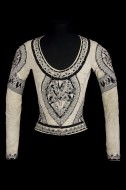SIBMAS-TLA Conference: Report from the Field, Part 2
Poetry in Motion: Dance and Movement Arts
With just a brief break for more breakfast foods and coffee, we piled back into the lecture hall for the first plenary session. Guided by Nena Couch from Ohio State University, we heard four presentations on work begin done to preserve, exhibit, and re-create dance works.
Libby Smigel of the Dance Heritage Coalition talked us through the challenges of maintaining and preserving archives for active but often underfunded dance companies. The DHC has set up a series of tools available on their website designed to support companies looking to preserve their performance documentation. Libby noted continuing issues around trust that hinder the donation of materials to libraries and archives. No one from the performing company wants to be denied access to their own materials, and the fear persists that once given, the records will exist in a sort of backlog limbo, never processed and never accessed. To alleviate this fear, Libby stressed the need to include the company in the archiving project. There is a difference between a company that feels the need to establish an archive and a once whose more immediate needs can be met with a functional records management system. Despite issues of funding and storage conditions, working directly with the companies puts the DHC and its fellows in the position to do the most lasting good.
Libby’s illuminating talk was followed by a video presentation from the National Center for Stage Costumes (CNCS) at Moulin, France. I pressed the translation headset to my ear while also (perhaps unwisely) trying to follow the narration with my very rusty high school French. The visuals on the screen made up for my lack of language skills. Thanks to a gift from the Rudolf Nureyev Foundation, the CNCS was able to mount an exhibition celebrating not only Nureyev’s work as a dancer, but also his life as a collector of beautiful things. The exhibition used objects from Nureyev’s collection to explore and comment on both his personal and professional life. The man had a taste for opulence, and I loved every expressed flourish.
We did a small hop across the channel from the beautiful gallery in France to the Victoria and Albert Museum in London. Dance curator Jane Pritchard spoke of the work she was doing with dance companies looking to reconstruct their own (or others) performance history. When it comes to recreating a past dance work, the archives are indispensible. Jane gave case studies that illustrated how the photographs, design renderings, written notations, recordings, and annotated musical scores can serve to support a reconstruction or reinterpretation of a work. The contemporary dance company or artist can use the archive as a map to reimagine a performance.
To reconstruct a performance using the archive, there must first be documentation that it took place. The final speaker of the morning, Merce Saumell from the Insituto del Teatro in Barcelona looked at questions surrounding documenting an ephemeral event. One of the major debates by artists creating time-based work is whether documentation should be happening at all. Some artists insist that there is no way to reconstruct a performed event, and that the attempt is like an attack on the original experience. Merce also brought up contemporary performance groups using nonlinear documentation that resists ordered work.
After a much needed break for lunch, the group split up to attend afternoon working sessions. Working Session II: Collections and Archives was just as chock full of information as the morning’s plenary. Isobel Johnstone at the National Library of Australia (NLA) gave us an account of the excellent resources being pulled together through TROVE, a cross repository platform supported by the NLA. A joint panel from Carnegie Hall and AVPreserve, an information management consulting firm, walked through the digital archive project currently underway at Carnegie Hall including insight into the selection process for a digital asset management system. Finally, Nichole Arvin from the Dance Theater of Harlem(DTH) presented on an exciting pilot course that got DTH dance students working with archival material and even documenting their own work. By the end of the working session, my brain had reached its capacity for new information and ideas. I was ready to wind down.
The evening ended with a reception generously hosted by the Shubert Foundation, where we concluded the day with wine, nibbles, and a beautiful view from the terrace. After spending the day together, we had a better sense of each other. The multi-lingual hum picked up again and the talk continued as small groups formed and reformed on the terrace, around the food, and even as we finally poured exhausted but bright-eyed back onto the street. The show was over, for the first day at least. And scene.
Morgen Stevens-Garmon
Museum of the City of New York

